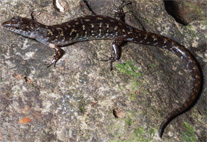Abstract
We review the recent discovery of multiple populations of the enigmatic, semi-aquatic Sphenomorphus Group skink, Parvoscincus leucospilos Peters, and investigate the morphological and genetic diversity of isolated, allopatric populations of this unique skink. Our investigations support the recognition of four unique evolutionary lineages distributed across Luzon Island in the Philippines, three of which are herein described as new species (P. tikbalangi sp. nov., P. manananggalae sp. nov., and P. duwendorum sp. nov.). All four recognized species are genetically divergent in both mitochondrial and nuclear DNA sequences, and morphologically distinct. The description of three new Luzon Island endemic species adds to the growing body of literature suggesting that mechanisms driving the accumulation of vertebrate diversity in the Philippines may vary regionally across the archipelago.

